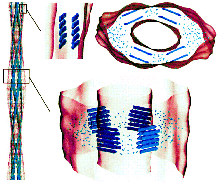Events Calendar
Institute for Condensed Matter Physics of the
National Academy of Sciences of Ukraine
Theoretical studies of protein aggregation

Protein aggregation refers to the proces of self-assembly of fully or partially unfolded proteins that leads to the formation of large insoluble complexes, aggregates. One type of protein aggreates – amyloid fibrils is implicated in various neurodegenertive diseases and also has found multiple uses in technology. We will discuss what can be learned about amyloid using theoretical models and methods. We will start with a broad overview of problems and challenges facing theoretical approaches, from the description of small oligomers[1], which are often considered kinetic intermediates to fibrils, to particlar details of amyloid structure[2]. Later on we will focus on aggregation pathway of the peptide involved in Alzheimer’s disease, Ab[3, 4]. Finally, we will present a model specifically designed for simulation of protein aggregates[5] and discuss the effect of electric field on amyloid assembly[6]
1. Baumketner, A. and J.E. Shea, Free energy landscapes for amyloidogenic tetrapeptides dimerization. Biophysical Journal, 2005. 89(3): p. 1493-1503.
2. Negureanu, L. and A. Baumketner, Microscopic Factors that Control beta-Sheet Registry in Amyloid Fibrils Formed by Fragment 11-25 of Amyloid beta Peptide: Insights from Computer Simulations. Journal of Molecular Biology, 2009. 389(5): p. 921-937.
3. Teplow, D.B., et al., Elucidating amyloid beta-protein folding and assembly: A multidisciplinary approach. Accounts Of Chemical Research, 2006. 39(9): p. 635-645.
4. Baumketner, A., M.G. Krone, and J.E. Shea, Role of the familial Dutch mutation E22Q in the folding and aggregation of the 15-28 fragment of the Alzheimer amyloid-beta protein. Proceedings of the National Academy of Sciences of the United States of America, 2008. 105(16): p. 6027-6032.
5. Ni, B. and A. Baumketner, Reduced atomic pair-interaction design (RAPID) model for simulations of proteins. Journal of Chemical Physics, 2012. 138(6): p. 064102.
6. Baumketner, A., Electric Field as a Disaggregating Agent for Amyloid Fibrils. Journal of Physical Chemistry B, 2014. 118(50): p. 14578-14589.


